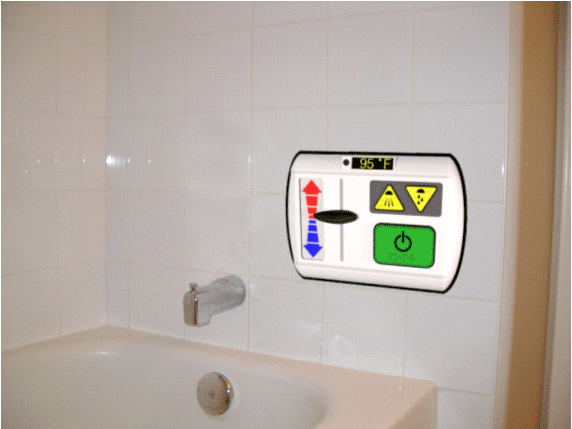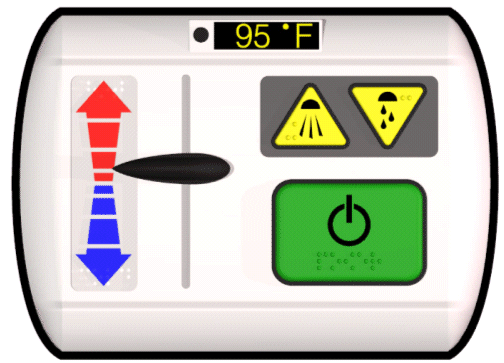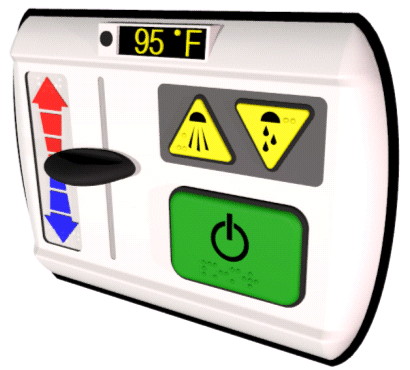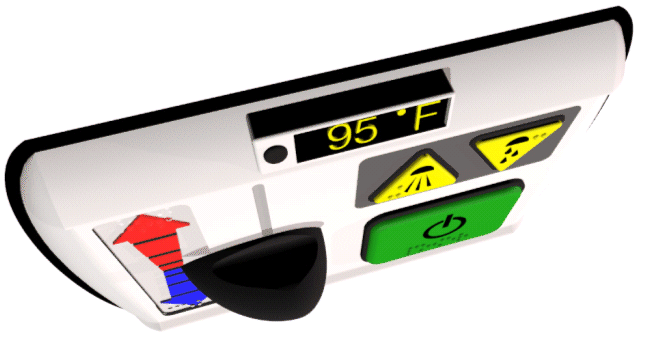The Water Wizard for safer bathing.
Tap-water scalds are very common among young children, older adults and people with disabilities. Petro, Belger, Slazberg, & Salisbury (1989) found scalding to be the second most common cause of injury in the elderly. Reasons for tap-water injuries or scalds include the inability to get out of extremely warm showers and baths (Weaver, Himel & Edlich, 1993), improper judgment of water temperature, delayed reaction time, peripheral neuropathy, and alterations of mental status (Petro, Belger, Slazberg & Salisbury, 1989). With aging, skin becomes thinner and more fragile decreasing the time to incur a severe burn at lower temperatures than the average adult (Government of Alberta Municipal Affaires, 2002).
Schmitz (2001) recommended installing anti-scald valves to increase bathing safety and independence for the elderly and disabled populations. Anti-scald devices stop or interrupt the flow of water when the temperature reaches a pre-determined temperature (generally between 43.3-45.6 degrees Celsius) therefore, preventing hot water from coming out of the tap before scalding occurs ("Tap Water Scalds", 2002). Anti-scald devices are necessary because an alternative burn prevention strategy of turning the hot-water tank temperatures below 60 degrees Celsius will promote the unwanted growth of Legionella pneumophilia bacteria, which causes Legionnaire's Disease (Weaver, Himel & Edlich, 1993). After analyzing the current anti-scalding device interfaces that are available, it was found that the devices were not intuitive for use by the aging population.
According to a 1984 survey, approximately 35 percent of people over the age of 65 years require assistance in order to perform bathing activities (National Center for Health Statistics, 1984). Bathing becomes more difficult with aging due to limited reach, poor grip strength and low levels of thermal sensitivity. The current design of showering devices that are presently available require a lot of standing; and the positioning of controls entails the use of a wide range of motion making it difficult to access the control device (Mullick, 1993). In designing the Water Wizard, the goal was to create an interface specifically for the elderly to use, while keeping in mind the seven principles of universal design (Connell et al., 1997).
The Water Wizard will facilitate safe bathing for all populations by significantly reducing the risk for burns. For an illustrated representation and dimensions of the product refer to Appendix A and B respectively. The installation height of the device can be customized according to the preferences and needs of the user. For example, the device should be placed at eye level for those bathing using a bathtub seat (L. Shephard, telephone interview, March 23, 2002). The Water Wizard is hooked up to a mixing valve, which contains a safety mechanism that turns the water off when the temperature reaches 43 degrees Celsius. In addition, the maximum temperature an individual can select using the device is 43 degrees Celsius. This dual safety feature will help to minimize burns. The temperature range of the Water Wizard is from 25 to 43 degrees Celsius. The maximum temperature for the device was determined by referring to a previous anti-scald device approved by the Canadian Standards Association which had a maximum water temperature of 43.3 degrees Celsius (Weaver, Himel, & Edlich, 1993). In addition, water temperature and burn times were also taken into consideration. For example, at 48 degrees Celsius the skin will sustain a third degree burn in five minutes (Miritz, & Herriques, 1947). Refer to Table 1 in Appendix B for details on water temperature and time required for a third-degree burn to occur. The large temperature range for the unit was chosen to accommodate for the variety in water temperature preferences of children, adults and the elderly.
The panel will be made out of a high temperature plastic such as high impact polystyrene (Lusko, 1999) making the device safe for use in the shower and bathtub. The slider and control buttons will be made of Santoprene ®, which is a thermoplastic elastomer (Advanced Elastomer Systems, 2002). This material is non-slip so that people with poor motor control have better access to the buttons. The white matte surface of the panel will decrease glare, which is a common problem for the elderly (Ergo/Gero Human Factors Science, 2001). All of the buttons will click to give both a tactile and auditory stimulus indicating that the button has been pressed. These buttons will be surrounded by a charcoal border, which increases contrast to improve visibility against the white matte background of the device (Ergo/Gero Human Factors Science, 2001). All text will be nine millimeters in height. This is the recommended height for text assuming the person using the device is 901 millimeters to 1800 millimeters away (Kroemer, & Grandjean, 1997). The text will be in MS reference Sans Serif for ease of readability. Since the controls are to be used in sequence they are arranged left to right (Kroemer and Grandjean, 1997).
The sliding temperature selector should be at least 25 to 30 millimeters in length (Kroemer and Grandjean, 1997). The selector for the device is much larger (refer to Table 2 in Appendix B) thereby making it large enough to accommodate users with reduced strength and structural deformities of the hand. Resistance for the sliding mechanism is three Newtons making the device accessible for individuals with reduced strength (T. Amell, personal communication, November 15, 2002). The slider has clicks at intervals of two degree Celsius and the change in these clicks will be easily detected. This audible and proprioceptive click feature reduces overshooting of desired temperature selection by all users especially those with ataxia. The interval size between clicks becomes larger at the extreme temperature ranges. Between clicks there is a gradual increase in temperature that is equivalent to two degrees Celsius. This allows the user to select a specific temperature based on personal preference. The sliding pointer is charcoal in color to improve contrast against the white background.
A colored visual scale indicates temperature selection. Blue was selected to indicate cooler temperature and red for warmer temperatures. Both the red and blue are vibrant throughout the temperature range due to difficulties by the elderly in detecting small variations in the same color (Ergo/Gero Human Factors Science, 2001). The width of the scale increases as the end of the temperature ranges are approached. The arrows located at the ends of the temperature indicator are used as a caution to inform the user that he or she is nearing extreme temperatures. This is especially important for color-impaired individuals (T. Amell, personal communication, November 15, 2002). Braille with the word for hot is above the red temperature section and Braille for cold is below the blue temperature section to improve awareness of temperature selected by individuals with visual impairments. In addition to the slider mechanism, a digital readout display, which is the most accurate for displaying precise data, will be located on top of the device (Kroemer, & Grandjean, 1997). This digital read out will be black with yellow lettering. A round charcoal button located on the left side of the digital readout will interchangeably display the temperature from degrees Celsius to degrees Fahrenheit. To prevent confusion, the digital temperature readout will display the selected units behind the numerical value.
The large green button on the Water Wizard is the on/off switch. If an emergency situation arises, the on/off button is very prominent and easy to press so that the water will be turned off immediately. A push button for an emergency stop must be no smaller than 30 to 40 millimeters (Kroemer and Grandjean, 1997). The on/off button for the Water Wizard is much larger than this requirement. Please refer to Table 2 in Appendix B for detailed measurements. This button is raised a few millimeters higher than the pressure buttons so that the user can easily detect the power button. While the device is on, a light will illuminate the button making it glow green, further enhancing its visibility. The international symbol for power will be black and the word power will be spelled in Braille on the surface of the button, enabling those with visual impairments to determine its function.
The two triangular yellow buttons allow the user to adjust the pressure amongst three pressure settings. The triangle pointing up increases the pressure while the triangle pointing down will decrease the pressure. These two buttons will be placed in a charcoal colored box. This allows the user to associate both buttons to one function, as in this case pressure. As shown in appendix A the yellow triangular buttons have symbols representing their function and Braille indicating "+" and "-".
The Water Wizard not only reduces the incidence of bathing in unsafe conditions but also enhances the quality of life for elderly persons by assisting them to become or maintain their independence in showering or bathing (Elderly Care Online, 1998). By reducing the incidence of burns that occur during bathing, health care related costs will subsequently decrease. Other users that would benefit from The Water Wizard include people with cognitive deficits, diabetes, reduced functional mobility and strength, visual impairments, reduced thermal sensitivity and young children. In Alberta, during the period of 1995 to 1999, children between ages one to four were found to have the highest incidence of scald burn injuries requiring hospitalization (Government of Alberta Municipal Affaires, 2002). Families with small children can install this device to prevent this type of injury from occurring. People with diabetes have a loss of sensation and poor circulation, which places them at a higher risk for burns, therefore benefiting from this device (The Center of Locomotion Studies, 2002). The Water Wizard can be installed to accommodate any user, regardless of age, size or degree of mobility.
References
- Advanced Elastomer Systems. (2002). Santoprene Rubber Physical Properties Guide. Retrieved November 18, 2002, from: http://www.santoprene.com/site/Resource_Library/Marketing_Information
- Elder Care Online. (1998). Tips for Personal Hygiene and Bathing. Retrieved November 18, 2002, from: http://www.ec-online.net
- Ergo/Gero Human Factors Science. (2001). Designing Marketing and Displays for the Older Consumer. Retrieved November 10, 2002, from: http://www.ergogero.com/pages/agingeye.html
- Government of Alberta Municipal Affairs (2002). Fire Commissioner's Office Burn Awareness Week. Retrieved November 3, 2002, from: http://www3.gov.ab.ca/ma/fco/BAWKit2002.cfm
- Kroemer, K. H., & Grandjean, E. (1997). Fitting the task to the human: A textbook of occupational ergonomics. London, EN: Taylor and Francis Ltd..
- Lesko, J. (1999). Chapter 8: Plastics. In Materials and manufacturing guide: Industrial design. New York, NY: John Wiley & Sons.
- Moritz, A. R., & Herriques, F. C. (1947). Studies of thermal injuries: the relative importance of time and surface temperature in the causation of cutaneous burns. American Journal of Pathology, 23, pp. 695-720.
- Mullick, A. (1993). Bathing for older people with disabilities. In Center for Inclusive Design & Environmental Access (Publications). Retrieved November 3, 2002, from: http://www.ap.buffalo.edu/idea/publications/free_pubs/pubs_bathing.html
- National Center for Health Statistics (1984). 1984 NHIS, Survey on aging. Vital and Health Statistics. Washington, DC.
- Petro, J. A., Belger, D., Salzberg, C. A., & Salisbury, R. E. (1989). Burn accidents and the elderly: what is happening and how to prevent it. Geriatrics, 44, pp. 26-36.
- Schmitz, T., (2000). Environmental assessment. In S. B. O'Sullivan & T. Schmitz (Eds.), Physical rehabilitation: assessment and treatment (p. 340). Philadelphia, PA: F. A. Davis Company.
- Tap water scalds (2002). In Burn Prevention (Section 7). Retrieved October 28, 2002, from: http://www.burnsurgery.org/modules/prevention/scalds/sec7.htm
- The Center for Locomotion Studies. (2002). The Diabetes Foot Clinic. Retrieved April 2, 2002, from: http://www.neuro.wustl.edu/neuromuscular/nother/diabetes.htm
- The Center for Universal Design (1997). The Principles of Universal Design (2nd ed.) [Brochure]. Connell, B. R. et al.: Authors.
- Weaver, A. M., Himel, H. N., & Edlich, R. F. (1993). Immersion scald burns: strategies for prevention. The Journal of Emergency Medicine, 11, pp. 397-402.
Appendix A
 |
 |
 |
 |
Appendix B
Contents of table from Mortiz, A. R. & Herriques, F. C. (1947).
